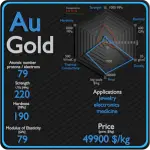This article contains comparison of key thermal and atomic properties of beryllium and copper, two comparable chemical elements from the periodic table. It also contains basic descriptions and applications of both elements. Beryllium vs Copper.

Beryllium and Copper – About Elements


Source: www.luciteria.com
Beryllium and Copper – Applications
Beryllium
Berylium can be utilized as alloying agent in production of beryllium-copper, X-ray detection diagnostics, manufacture of computer peripherals, in nuclear reactors as neutron moderators and reflectors. 80% of the beryllium used goes into copper beryllium alloys. The combination of light weight with high strength at extreme temperatures makes beryllium metal and aluminium beryllium alloys ideal for use in high performance aerospace applications such as components of rockets. Transparency to x-radiation makes pure beryllium metal essential in security equipment and high-resolution medical imaging technology, such as mammography to detect breast cancer. Copper beryllium is the hardest and strongest of any copper alloy (UTS up to 1,400 MPa), in the fully heat treated and cold worked condition. It combines high strength with non-magnetic and non-sparking qualities and it is similar in mechanical properties to many high strength alloy steels but, compared to steels, it has better corrosion resistance.
Copper
Historically, alloying copper with another metal, for example tin to make bronze, was first practiced about 4000 years after the discovery of copper smelting, and about 2000 years after “natural bronze” had come into general use. An ancient civilization is defined to be in the Bronze Age either by producing bronze by smelting its own copper and alloying with tin, arsenic, or other metals. The major applications of copper are electrical wire (60%), roofing and plumbing (20%), and industrial machinery (15%). Copper is used mostly as a pure metal, but when greater hardness is required, it is put into such alloys as brass and bronze (5% of total use). Copper and copper-based alloys including brasses (Cu-Zn) and bronzes (Cu-Sn) are widely used in different industrial and societal applications. Some of the common uses for brass alloys include costume jewelry, locks, hinges, gears, bearings, ammunition casings, automotive radiators, musical instruments, electronic packaging, and coins. Bronze, or bronze-like alloys and mixtures, were used for coins over a longer period. is still widely used today for springs, bearings, bushings, automobile transmission pilot bearings, and similar fittings, and is particularly common in the bearings of small electric motors. Brass and bronze are common engineering materials in modern architecture and primarily used for roofing and facade cladding due to their visual appearance.
Beryllium and Copper – Comparison in Table
| Element | Beryllium | Copper |
| Density | 1.848 g/cm3 | 8.92 g/cm3 |
| Ultimate Tensile Strength | 345 MPa | 210 MPa |
| Yield Strength | N/A | 33 MPa |
| Young’s Modulus of Elasticity | 287 GPa | 120 GPa |
| Mohs Scale | 5.5 | 3 |
| Brinell Hardness | 600 MPa | 250 MPa |
| Vickers Hardness | 1670 MPa | 350 MPa |
| Melting Point | 1278 °C | 1084.62 °C |
| Boiling Point | 2469 °C | 2562 °C |
| Thermal Conductivity | 200 W/mK | 401 W/mK |
| Thermal Expansion Coefficient | 11.3 µm/mK | 16.5 µm/mK |
| Specific Heat | 1.82 J/g K | 0.38 J/g K |
| Heat of Fusion | 12.2 kJ/mol | 13.05 kJ/mol |
| Heat of Vaporization | 292.4 kJ/mol | 300.3 kJ/mol |














